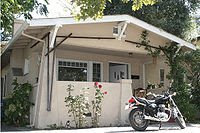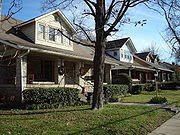Thursday, April 2, 2009
Title insurance in the United States
It is meant to protect an owner's or a lender's financial interest in real property against loss due to title defects, liens or other matters. It will defend against a lawsuit attacking the title as it is insured, or reimburse the insured for the actual monetary loss incurred, up to the dollar amount of insurance provided by the policy.
The first title insurance company, the Law Property Assurance and Trust Society, was formed in Pennsylvania in 1853.[1] Title insurance was created in the United States by William Penn and the vast majority of title insurance policies are written on land within the U.S.
Typically the real property interests insured are fee simple ownership or a mortgage. However, title insurance can be purchased to insure any interest in real property, including an easement, lease or life estate. Just as lenders require fire insurance and other types of insurance coverage to protect their investment, nearly all institutional lenders also require title insurance to protect their interest in the collateral of loans secured by real estate. Some mortgage lenders, especially non-institutional lenders, may not require title insurance.
Title insurance is available in many other countries, such as Canada, Australia, United Kingdom, Northern Ireland, Mexico, New Zealand, China, Korea and throughout Europe. However, while a substantial number of properties located in these countries are insured by US title insurers, they do not constitute a significant share of the real estate transactions in those countries.
They also do not constitute a large share of US title insurers' revenues. In many cases these are properties to be used for commercial purposes by US companies doing business abroad, or properties financed by US lenders.
The US companies involved buy title insurance to obtain the security of a US insurer backing up the evidence of title that they receive from the other country's land registration system, and payment of legal defense costs if the title is challenged.
Real estate trends
A real estate trend is the catalyst for the change, and it is usually a concept, a belief, a philosophy, or an event. Sometimes a real estate trend evolves to meet a specific need, while others evolve when new products or solutions are launched.
For example, when more lenders began offering creative financing products, more borrowers were able to afford a mortgage (at least on paper). At other times, a trend from another industry spills over into the real estate industry and is adopted.
Real estate trading
"I buy yours you buy mine"
arrangement. This is distinct from vacation home swapping.
The deteriorating real estate market (circa 2006+) has led many to realize that trading may be an extremely viable approach to selling one's real estate. This approach only works if the seller is also looking to buy another property, such as a move or relocation. However, it is possible to move up or down in price, size, etc, or even trade to another city or state entirely.
While related, real estate trading is different than 1031 Exchanges. 1031 exchanges are a way to defer capital gains tax on investment properties. 1031 exchanges do need to involve an actual trade of real estate between two parties.
Real estate investment trust
Like other corporations, REITs can be publicly or privately held. Public REITs may be listed on public stock exchanges like shares of common stock in other firms.
REITs can be classified as equity, mortgage or hybrid.
The key statistics to look at in a REIT are its NAV (Net asset value), AFFO (Adjusted Funds From Operations) and CAD (Cash Available for Distribution). REITs face challenges from both a slowing economy and the global financial crisis, depressing share values by 40 to 70 per cent in some cases
Real estate development
Developers are the coordinators of those activities, converting ideas on paper into real property. They create, imagine, fund, control and orchestrate the process of development from the beginning to end.
Developers usually take the greatest risk in the creation or renovation of real estate -- and receive the greatest rewards. Typically, developers purchase a tract of land, determine the marketing of the property, develop the building program and design, obtain the necessary public approvals and financing, build the structure, and lease, manage, and ultimately sell it.
Private equity real estate
Investments are typically made via private equity real estate fund, a collective investment scheme, which pools capital from investors. These funds typically have ten year life span consisting of a 2-3 year investment period during which properties are acquired and a holding period during which active asset management will be carried out and the properties will be sold.
Appraised value
When obtaining a mortgage the funding lender relies on the standardized valuation methods of an appraiser to asses a monetary value for the specific piece of real property on which a loan will be secured (e.g. a residence). The lender will then justify the loan amount (and other risk-based pricing) factors as a percentage of the appraised value of the property.
Appraised values can also be made after a property sale. For example, home owners wishing to gain access to their increased equity in their home may obtain a mortgage valuation to prove its value has risen and thus justify increasing the amount of their mortgage. Also, the various states of Australia each have a Valuer-General's Department, which regularly assess land values in all municipalities and shires for the purpose of issuing property tax notices.
A low appraised value will affect a buyer's ability to purchase a property. This is because the loan amount would seem too high with respect to the value. Unless the buyer can come up with the difference, the buyer will unlikely be able to qualify for the loan.
Real estate appraisal
The need for appraisals arises from the heterogeneous nature of property as an investment class: no two properties are identical, and all properties differ from each other in their location - which is the most important determinant of their value.
So there cannot exist a centralised Walrasian auction setting for the trading of property assets, as there exists for trade in corporate stock. The absence of a market-based pricing mechanism determines the need for an expert appraisal/valuation of real estate/property.
Although some areas require no license or certification at all, a real estate appraisal is generally performed by a licensed or certified appraiser (in many countries known as a property valuer or land valuer and in British English as a "valuation surveyor").
If the appraiser's opinion is based on Market Value, then it must also be based on the Highest and Best Use of the real property. For mortgage valuations of improved residential property in the US, the appraisal is most often reported on a standardized form, such as the Uniform Residential Appraisal Report.
Appraisals of more complex property (e.g. -- income producing, raw land) are usually reported in a narrative appraisal report.
Abstract of title
In the United States, the abstract of title furnishes the raw data for the preparation of a policy of title insurance for the parcel of land in question. An abstract of title should be distinguished from an opinion of title.
While an abstract states that all of the public record documents concerning the property in question are contained therein, an opinion states the professional judgment of the person giving the opinion as to the vesting of the title and other matters concerning the status of the chain of title.
Many jurisdictions define the giving of an opinion of title as the practice of law, thus making it unlawful for a non-attorney to do so
Mansion



Villa



Bungalow




![The majority of Chicago Bungalows were built between 1910 and 1940. They were typically constructed from brick (sometimes in decorative patterns) and had one and a half stories. At one point, nearly a third of the houses in the Chicago area were bungalows. One primary difference between the Chicago bungalow and other types is that the gables are parallel to the street, rather than perpendicular. Like many other local homes, Chicago bungalows are relatively narrow, [3] being an average of 20 feet (6.1 m) wide on a standard 25-foot (7.6 m) wide city lot.](https://blogger.googleusercontent.com/img/b/R29vZ2xl/AVvXsEhxNPnLg1rPTqM-Q8xAds0a113P6aZ0_i7wS4Zs_oSqDo5ZZQU8iEoPn-0mHSJT04wEW_lpodcfFAtB1vyHeGQGJiBp_j4msK4oN6NILMgSKkdI2T-DAZUlDGUkBa1w0H-Xgy8Xv5WAon4/s320/180px-Summer_2006_0882.jpg)




Bungalows are very convenient for the homeowner in that all living areas are on a single storey and there are no stairs between living areas. A bungalow is well suited to those who are mobility impaired, e.g. the elderly or those in wheelchairs.
Neighborhoods of only bungalows offer more privacy than similar neighborhoods with two-story houses. With bungalows, strategically planted trees and shrubs are usually sufficient to block the view of neighbors. With two-story houses, the extra height requires much taller trees to accomplish the same, and it may not be practical to place such tall trees close to the house to obscure the view from the second floor of the next door neighbor. On the other hand, even closely spaced bungalows make for quite low density neighborhoods, contributing to urban sprawl.
Single-family detached home
There are also many disadvantages to owning a single-family detached home. All maintenance and repair costs—interior, exterior and everything in between—are at the owner's expense. There is often a lack of amenities such as pools and playgrounds (although some single-detached homes do have these features within the lot or nearby, their owners are commonly required to pay a homeowners fee as those in condos or townhomes).
Landscaping and lawn upkeep costs are at the owner's expense.


Public Housing
 Public housing is a form of housing tenure in which the property is owned by a government authority, which may be central or local. Social housing is an umbrella term referring to rental housing which may be owned and managed by the state, by not-for-profit organizations, or by a combination of the two, usually with the aim of providing affordable housing.
Public housing is a form of housing tenure in which the property is owned by a government authority, which may be central or local. Social housing is an umbrella term referring to rental housing which may be owned and managed by the state, by not-for-profit organizations, or by a combination of the two, usually with the aim of providing affordable housing.Public housing was only built with the blessing of the local government, and projects were almost never built on suburban greenfields , but through regeneration of older neighborhoods. The destruction of tenements and eviction of their low-income residents consistently created problems in nearby neighborhoods with "soft" real estate markets.
Houses, apartments or other residential units are usually subsidized on a rent-geared-to-income (RGI) basis. Some communities have now embraced a mixed income, with both assisted and market rents, when allocating homes as they become available.
Cohousing
 A cohousing community is a type of intentional community composed of private homes with full kitchens, supplemented by extensive common facilities. A cohousing community is planned, owned and managed by the residents, groups of people who want more interaction with their neighbours. Common facilities vary but usually include a large kitchen and dining room where residents can take turns cooking for the community. Other facilities may include a laundry, pool, child care facilities, offices, internet access, game room, TV room, tool room or a gym. Through spatial design and shared social and management activities, cohousing facilitates intergenerational interaction among neighbors, for the social and practical benefits. There are also economic and environmental benefits to sharing resources, space and items.
A cohousing community is a type of intentional community composed of private homes with full kitchens, supplemented by extensive common facilities. A cohousing community is planned, owned and managed by the residents, groups of people who want more interaction with their neighbours. Common facilities vary but usually include a large kitchen and dining room where residents can take turns cooking for the community. Other facilities may include a laundry, pool, child care facilities, offices, internet access, game room, TV room, tool room or a gym. Through spatial design and shared social and management activities, cohousing facilitates intergenerational interaction among neighbors, for the social and practical benefits. There are also economic and environmental benefits to sharing resources, space and items.The Sunward Cohousing community illustrating greenspace preservation, tightly clustered housing, and parking on periphery, Ann Arbor, Michigan, 2003.

Design:
Because each cohousing community is planned in its context, a key feature of this model is its flexibility to the needs and values of its residents and the characteristics of the site. Cohousing can be urban, suburban or rural. The physical form is typically compact but varies from low-rise apartments to townhouses to clustered detached houses.
They tend to keep cars to the periphery which promotes walking through the community and interacting with neighbors as well as increasing safety for children at play within the community. Shared green space is another characteristic, whether for gardening, play, or places to gather.
When more land is available than is needed for the physical structures, the structures are usually clustered closely together, leaving as much of the land as possible "open" for shared use. This aspect of cohousing directly addresses the growing problem of suburban sprawl.
Single-family detached home
A single-family detached home, or single-family home or detached house for short, also variously known as a single-detached dwelling or separate house (see below), is a free-standing residential building. Most single-family homes are built on lots larger than the structure itself, adding an area surrounding the house, which is commonly called a yard in North American English or a garden in British English. Garages can also be found on most lots. In older homes, they are typically detached, standing as a separate building, either near a driveway or facing an alley in urban areas. Newer homes in North America favor attached garages, often facing the street, as most recent developments do not include alleys.
A sample floor plan of a single-detached home
Duflex House

A duplex house is a dwelling comprising two units either side-by-side or on two different floors. The former often looks like two houses put together, sharing a wall (compare semi-detached); the latter usually appears as a townhouse, but with two different entrances.
The term "duplex" can also be extended to three-unit and four-unit buildings, or they can be referred to with specific terms such as triplex and fourplex or quadplex.[1] Because of the flexibility of the term, the line between an apartment building and a duplex is somewhat blurred, with apartment buildings tending to be bigger, while duplexes are usually the size of a normal house.
A duplex may be purchased a single piece of real estate, or there can be separate titles for each unit. The latter is more common with semi-detached buildings where the units only share a common party wall, however it is possible for units of a duplex (or triplex or fourplex) to be owned by different owners.
This is an example of a common 20th Century duplex home built in New England.
Condominium
A condominium may be simply defined as an "apartment" that the tenant "owns" as opposed to rents.
 Aqua waterfront condos in Long Beach, California
Aqua waterfront condos in Long Beach, California The interior of a loft condominium
The interior of a loft condominium
A historic mansion converted into luxury condominiums in Chicago
Terrace Houses
The terrace house has housed different parts of the social spectrum in western society. Originally associated with the working class, in modern times, historical and reproduction terraces have been widely associated with the process of gentrification.

Terraced houses in Fortuneswell, Isle of Portland, Dorset, UK

A street of British Victorian/Edwardian terraced homes.

Grosvenor Square, one of the earliest terraces in England

East side of the Place des Vosges, Paris. One of the earliest examples of terraced housing

Carlton House Terrace, London

Royal Crescent, Bath (1767-1777)

Park Crescent, Regent's Park, London

Dormer top terraces

BedZED zero energy terraced houses in Beddington, London

Gambier Terrace in Liverpool


























